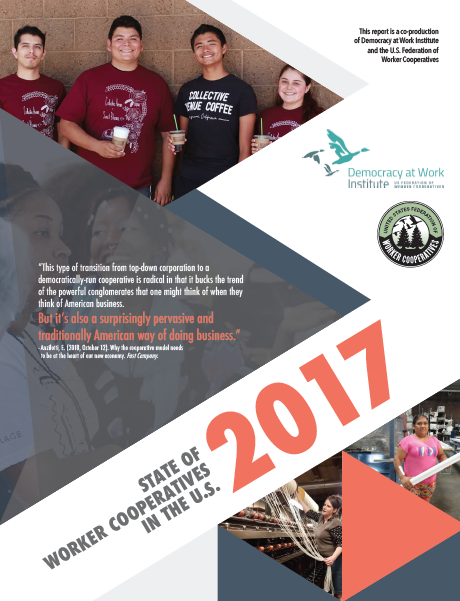Conversions of conventional firms represent 25 percent of new coops
by Karen Kahn

In their annual report, “Worker Cooperatives: State of the Sector,” the Democracy at Work Institute (DAWI) and the U.S. Federation of Cooperatives paint a picture of the cooperative sector and how it is changing over time. Among the key findings, the sector continues to grow at a slow but steady pace, with conversions of traditional business an increasing share of new cooperative enterprises.
The just-released report, which tabulates data from 105 responses to a survey of 394 worker cooperatives, identifies 450 of these businesses in the U.S. at the time of publication. This number includes the 394 surveyed cooperatives, 6 new cooperatives that formed in 2018, and 50 cooperatives operating in Puerto Rico. These businesses employ 6,734 workers and bring in gross revenues of $467 million. Compared to 2016, this data shows 100 fewer workers across the sector but an increase in revenues of $40 million.
Excluding Puerto Rico, 37 new worker cooperatives were formed in 2017. Of these, 25 percent were identified as conversions from conventional businesses and nearly 70 percent as business startups. The percentage of conversions grew incrementally (2 percent) between 2016 and 2017.
Of new worker cooperatives formed in 2017, 25 percent represented conversions of conventional businesses.
Owned and governed by their employee owners, worker cooperatives distribute profits to employees based on hours worked, comparative salary, or another formula that reflects the employees’ contribution to the company through their labor. Employees vote for the company board on a one-worker-one-vote basis, and, in some cases, may also participate in company management.
With 2.3 million baby boomer business owners close to retirement, DAWI and others believe there is a real opportunity to grow worker cooperatives by converting these businesses to employee ownership. A map of the U.S., included in the report, shows that regions with technical and financial partners supporting conversions are leading the movement to grow the sector. Over the last five years, California, New York, Washington State, and Colorado have seen the formation of 62 new worker cooperatives. Of the 15 states with the largest number of cooperatives, 12 have organizations on the ground that are participating in the Workers to Owners collaborative, a network of intermediaries supporting cooperative conversions.
Regions with technical and financial partners supporting conversions are leading the movement to grow the sector.
Democratically run worker cooperatives offer workers a more equitable workplace. Wages are not high (many cluster around $12-$15 per hour) but the difference between the pay ratio between the highest and lowest pay among the vast majority of co-ops is 2:1 as compared to 303:1 at large U.S. corporations. And most importantly, workers share in the profits of their workplaces. Payments in 2017 ranged from $700 to nearly $2 million, shared among the collective membership. The median payout was $33,697.
One of the attractive aspects of democratic ownership is that worker cooperatives can be more focused on welcoming marginalized workers. People of color, women, and LGBT people tend to be well represented among employee owners at these type of enterprises. This year’s survey bears this out. Among the businesses that responded to the survey, the workforce was 45 percent Latino, 11 percent Black, and 39 percent white.
Karen Kahn is a writer, editor and communications consultant. She edits the Fifty by Fifty blog.
Fifty by Fifty, an initiative of @Democracy Collab, is working to transform the U.S. economy by growing employee ownership. Join our campaign, and we’ll send our monthly newsletter, filled with great company stories, right to your inbox.
